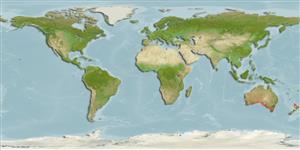Teleostei (teleosts) >
Perciformes/Scorpaenoidei (Scorpionfishes) >
Triglidae (Searobins) > Triglinae
Etymology: Lepidotrigla: Greek, lepis, lepidos = scale + Greek, trigla, es = red mullet (Ref. 45335).
More on author: Cuvier.
Environment: milieu / climate zone / depth range / distribution range
Ecology
Marine; demersal; depth range ? - 60 m (Ref. 33616). Temperate; 28°S - 43°S
Eastern Indian Ocean: southern Australia, from Western Australia to New South Wales and Tasmania.
Size / Weight / Age
Maturity: Lm ? range ? - ? cm
Max length : 20.0 cm SL male/unsexed; (Ref. 33616)
Short description
Morphology | Morphometrics
Dorsal
spines
(total): 8 - 9;
Dorsal
soft rays
(total): 13-15;
Anal
spines: 0;
Anal
soft rays: 13 - 15;
Vertebrae: 30 - 31. Adults have scute-like lateral line scales, a prominent white-edged dark blotch on the first dorsal fin, a broad pale band on the caudal fin, and blackish green color on the inner surface of the large pectoral fins (Ref. 33616).
Found in bays and coastal marine waters, over the continental shelf (Ref. 33616).
Life cycle and mating behavior
Maturity | Reproduction | Spawning | Eggs | Fecundity | Larvae
Neira, F.J., A.G. Miskiewicz and T. Trnski, 1998. Larvae of temperate Australian fishes: laboratory guide for larval fish identification. University of Western Australia Press. 474 p. (Ref. 33616)
IUCN Red List Status (Ref. 130435)
Threat to humans
Harmless
Human uses
Fisheries: of no interest
More information
Common namesSynonymsMetabolismPredatorsEcotoxicologyReproductionMaturitySpawningSpawning aggregationFecundityEggsEgg development
Age/SizeGrowthLength-weightLength-lengthLength-frequenciesMorphometricsMorphologyLarvaeLarval dynamicsRecruitmentAbundanceBRUVS
ReferencesAquacultureAquaculture profileStrainsGeneticsElectrophoresesHeritabilityDiseasesProcessingNutrientsMass conversion
Tools
Warning: mysqli::__construct(): (HY000/1040): Too many connections in /var/www/html/includes/speciessummary.lib.php on line 2414
Can't connect to MySQL database fbquizv2. Errorcode: Too many connections
